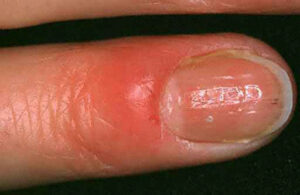Paronychia is a common problem seen on almost a daily basis in my Woodlands dermatology and Conroe dermatology offices. It is essentially nail fold swelling which is usually due to an infectious cause such as Candida. Patients that remove their nail cuticles are very predisposed to this condition. The cuticle is a crucial barrier that protects the nail unit from infection as it seals the nail fold to the nail plate. When the cuticle is removed, Candida and bacteria easily penetrate into the nail unit and cause a very painful swelling of the nail fold that lines the nail plate. It can become red, tender and expand due to formation of an abscess comprised of pus which may have to be drained. As the inflammation of paroynychia occurs over the nail matrix (the cells in the nail unit which produce the nail), temporary damage occurs on the matrix producing a distorted nail plate. The first step in treating paronychia is using an antibiotic and an antifungal to eliminate the microorganisms that have infected the nail fold. Occasionally, an abscess must be incised and drained. Once the infection has resolved, topical steroids are used on the nail fold to decrease the inflammation and ultimately allow the nail fold to grow a new cuticle which will attach to the nail plate. In severe cases of paroynychial inflammation, intralesional kenalog is performed where steroid is injected directly into the nail fold with a very small needle.
September 27, 2010




